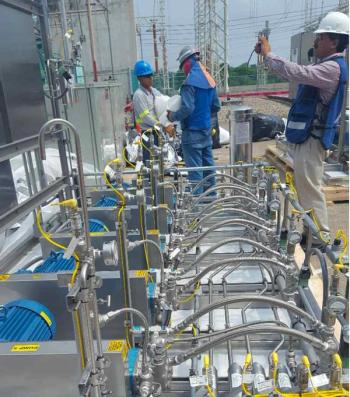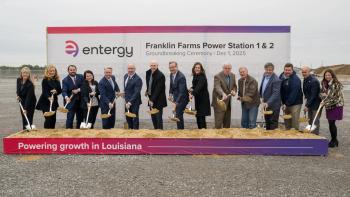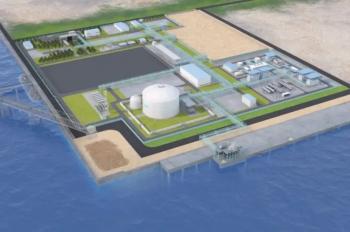
TURBOMACHINERY SELECTION AND PLANT SUCCESS
Ted Pintcke, Senior Project Development Director, Energy Division, Black & Veatch Corporation (B&V), views the turbomachinery landscape thru the lens of B&V’s experience in having completed over 150 combined cycle projects and the deployment of over 600 GTs in power applications.
What changes have you observed over the past three years in industrial plants?
We have seen economic and regulatory uncertainty play a significant role in the rate of gas turbine and compressor deployment. As a result, North American utilities have undertaken a number of planning projects and studies. Generally speaking, they are evaluating application of new generation turbines, equipment selection with an eye toward meeting customer needs, and in some cases, permitting information related to emissions-all in anticipation of nearer-term projects.
What have you observed in the following categories:
Aeroderivatives?
Movement towards aeroderivatives has occurred in the area of wind and renewable source firming. This is typically prevalent in regions with significant solar and wind energy resources such as the Pacific Northwest, Upper Midwest and Southwestern U.S. as well as portions of Canada. Similarly, we also see aeroderivative use in turbines and compressors utilized in developing gas and oil infrastructure including LNG and gas pipeline infrastructure.
Based on Black & Veatch’s own projections, we find our industry in the early stages of building out additional gas and oil pipeline infrastructure to accommodate the development of shale gas resources and anticipate expanded use of the technology.
In addition, we have seen a number of aeroderivatives applications this past year serving small industry and district heating applications in Russia and Eastern Europe as well as in Floating LNG Liquefaction, Storage and Offloading areas.
F-class turbines?
Most manufacturers have advanced their technology to increase output and efficiency when compared to industry-standard, F-class turbines of the early 2000s. Today, as utilities compete to provide their services and demonstrate low-cost option credentials, there is an increased demand for more efficient turbines.
New options today include more advanced F, G, H, and even J class units. If domestic natural gas pricing remains at current, historically low levels for the extended term, we expect that new generation F-class gas turbines as well as the more costly and efficient G, H and J class units will be deployed here in North America.
However, in Japan, South Korea, and other countries, significantly higher gas prices will drive deployment of high efficiency G, H and J class units. This trend will continue until LNG exports from the U.S. or other sources reduce the fuel source disparity between the regions.
Centrifugal compressors?
Given the trends in the market, centrifugal compressors are the clear preference for natural gas liquefaction. With recent global developments expanding the availability and use of natural gas, many new projects are under development. These projects include LNG production for export and LNG production for transportation fuel.
Combined cycle versus simple cycle?
We anticipate continuing movement towards combined cycle units due to their greater efficiency and design advances enabling faster response to changing load. This shift to combined cycle technology is driven by a variety of factors including pursuit of the lowest production cost, managing capacity needs, and an emission-focused regulatory environment. We note that with respect to wind firming, the initial consensus was that simple cycle would be the technology of choice; primarily in the form of aeroderivatives.
With the frequency of changes in wind and solar production, the actual run time for these turbines is quite large (with respect to hours per year) particularly as the amount of renewable energy grows.
Higher capacity factors and higher fuel costs will require each region or situation to find that “right” balance of simple cycle and fast responding combined cycle. It should also be noted that in some cases a niche exists for advanced reciprocating engines now filling that gap between simple and combined cycle.
What influences your customers’ choice of GTs and compressors?
While it varies somewhat by industry, it usually boils down to lowest life cycle cost and reliability. Our clients — whether regulated utilities or private power generators — have to compete to develop their projects. In most regions or ISOs, they have to demonstrate the most efficient and low-cost option in the queue as units are called upon for energy. Our customers also have to accommodate many other moving targets including faster ramp rates, scalability, and evolving emissions standards. Similarly, with respect to compressors, efficiency and reliability are the top concerns. Price, efficiency, reliability, cost to maintain, and ramp rates are the main drivers of purchasing decisions.
How is the use of smaller gas turbines and microturbines evolving?
Black & Veatch has applied micro and small gas turbines to back-up data centers, hospitals and industries where users must have energy certainty. Use of these technologies also extends to the telecom space as data-heavy, reliability- focused participants call for certainty.
Given the power reliability demands of an expanding number of industries, coupled with advances in competing technologies like fuel cells and battery storage, we anticipate increased competition for micro and smaller turbines.
What is the biggest challenge you face in GT and compressor selection?
Being able to stand behind and guarantee new or unproven technologies. There has been much innovation in GT technology, but only some of these advanced designs have operated with enough run hours to call them proven.
EPC project owners and financing entities expect reliability and performance guarantees. We aim to be transparent with clients about the benefits and risks of new technologies. We seek to achieve collaboration between all stakeholders so that no one party is responsible for shouldering all of the financial and performance risk when deploying new, more efficient technologies.
Looking ahead, where do you see the turbomachinery market heading?
Growth in the turbomachinery market will be driven by three key factors: the continuing recovery of the U.S. economy; further growth in renewables share of the energy portfolio; and the continuing development of emerging markets (countries and industries). On a global basis, we anticipate years of steady growth and the application of new turbine and compressor technologies.
Newsletter
Power your knowledge with the latest in turbine technology, engineering advances, and energy solutions—subscribe to Turbomachinery International today.





